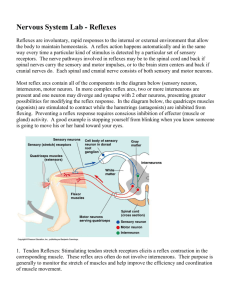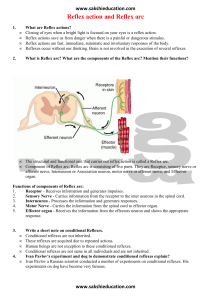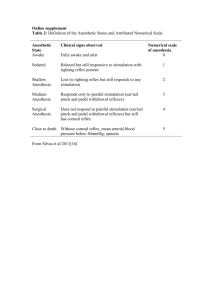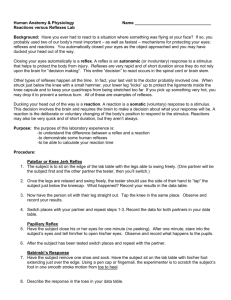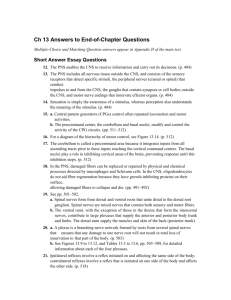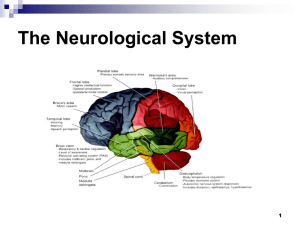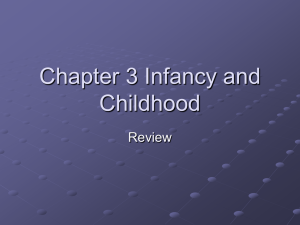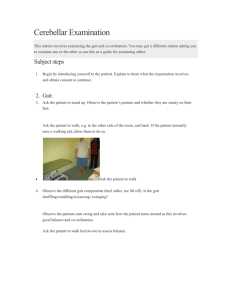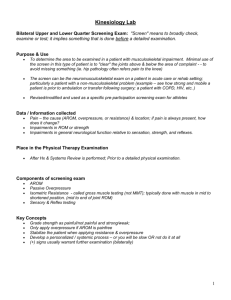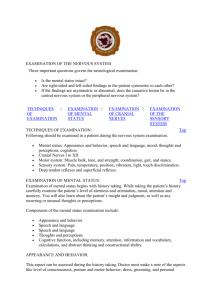LP 4 ENGL
advertisement
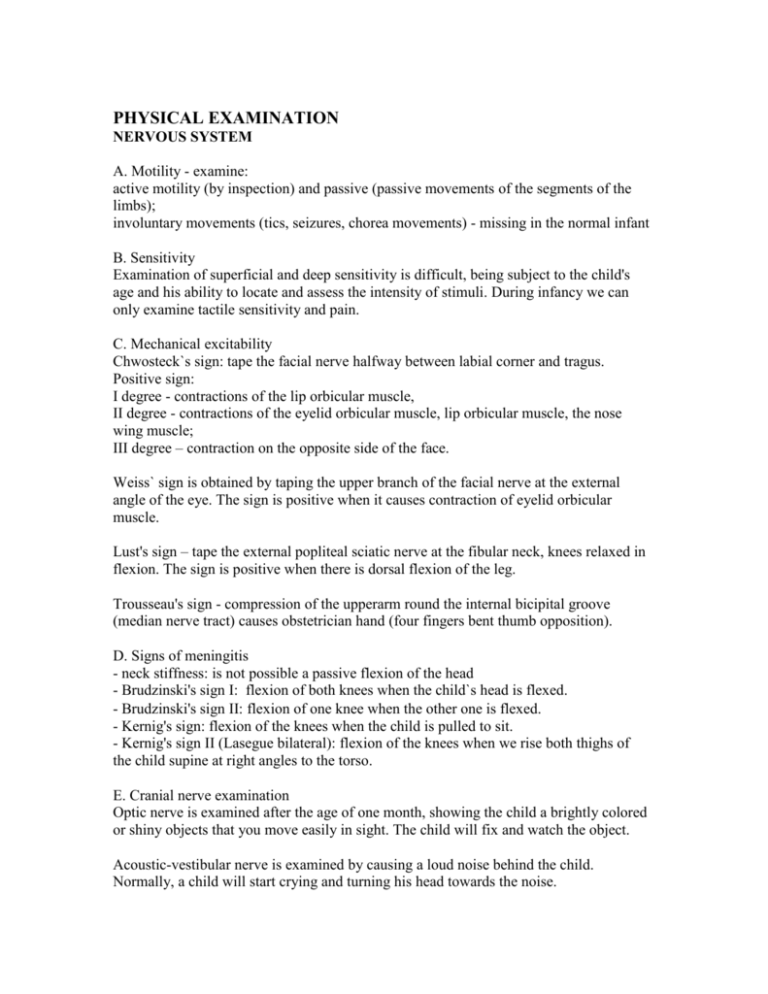
PHYSICAL EXAMINATION NERVOUS SYSTEM A. Motility - examine: active motility (by inspection) and passive (passive movements of the segments of the limbs); involuntary movements (tics, seizures, chorea movements) - missing in the normal infant B. Sensitivity Examination of superficial and deep sensitivity is difficult, being subject to the child's age and his ability to locate and assess the intensity of stimuli. During infancy we can only examine tactile sensitivity and pain. C. Mechanical excitability Chwosteck`s sign: tape the facial nerve halfway between labial corner and tragus. Positive sign: I degree - contractions of the lip orbicular muscle, II degree - contractions of the eyelid orbicular muscle, lip orbicular muscle, the nose wing muscle; III degree – contraction on the opposite side of the face. Weiss` sign is obtained by taping the upper branch of the facial nerve at the external angle of the eye. The sign is positive when it causes contraction of eyelid orbicular muscle. Lust's sign – tape the external popliteal sciatic nerve at the fibular neck, knees relaxed in flexion. The sign is positive when there is dorsal flexion of the leg. Trousseau's sign - compression of the upperarm round the internal bicipital groove (median nerve tract) causes obstetrician hand (four fingers bent thumb opposition). D. Signs of meningitis - neck stiffness: is not possible a passive flexion of the head - Brudzinski's sign I: flexion of both knees when the child`s head is flexed. - Brudzinski's sign II: flexion of one knee when the other one is flexed. - Kernig's sign: flexion of the knees when the child is pulled to sit. - Kernig's sign II (Lasegue bilateral): flexion of the knees when we rise both thighs of the child supine at right angles to the torso. E. Cranial nerve examination Optic nerve is examined after the age of one month, showing the child a brightly colored or shiny objects that you move easily in sight. The child will fix and watch the object. Acoustic-vestibular nerve is examined by causing a loud noise behind the child. Normally, a child will start crying and turning his head towards the noise. For gustatory nerve examination use two bottles with tea: in one add sugar and in the other a bitter substance (phenobarbital). The infant receives with pleasure the bottle with sugar and rejects the other. Hypoglossal nerve examination is better done from birth: put a few drops of glucose solution on the tongue and observe if there is swallowing reflex. F. Reflexes The baby has two types of reflexes: primitive reflexes and common adult reflexes. Primitive reflexes are characteristic in the newborn and persist up to 3-4 months. Their persistence above the age of 4 months shows neurologic retardation, and their asymmetry indicates unilateral lesions of the central or peripheral nervous system. Rooting reflex: touch the skin at the corner of the mouth; the infant will turn the head towards the stimulus and will do sucking movements. Moro reflex (Startle reflex): we fail to sustain the head and the neck of the infant; the upper limbs will have a quick movement of extension and abduction. Disappears after 2 months of age. Grasping reflex: we put our finger in infant`s hand and his fingers will cover our finger Tonic neck reflex (Fencing reflex): the infant placed supine, we turn his head to right or left; on the side the face is turn to the forearm is lifted, with the extension of the elbow and the knee is flexed; the other elbow is flexed and the other knee is in extension. Stepping reflex: he infant is placed with his soles on the table and moved forward suddenly - he will tend to recover the body position and will do a few steps. Placing reflex: hold the infant next to a table and touch the back of the leg to the edge of the table; the infant will put his foot on the table. Deep tendon reflexes Pattela reflex: taping the pattela`s tendon causes the knee extension. Achilean reflex: taping Achilles tendon causes the leg extension. Deep tendon reflexes of the upper limbs occur during the first year of life and are not taken during the current exam. Cutaneous reflexes Cutaneous plantar reflex: Babinski reflex is normal during infancy and even until two years of age. Abdominal skin reflexes (upper, middle and lower) appear after the age of two months; excitations cause a localized or a depressant rapid contraction of the abdomen muscles. Cremasterian reflex: the excitation of the fine skin of the thigh produces the rise of testicle in the scrotum on the same side. E. CAVITIES EXAMINATION By inspection we can examine the nasal cavities, ear canal and anus. When examining the external ear canal we look for the sign of ear sensitivity (vauchez) (press the tragus to seal duct; air column exerts pressure on the tympanic membrane, which, if inflamed, is painful so the child will scream). Oral cavity examination is made at the end of the physical exam, as it is more unpleasant for the child who may respond by crying and / or vomiting, compromising the rest of the physical examination. The infant is held facing the light and back on the right shoulder of the nurse which immobilizes his upper and lower limbs. Mouth examination may reveal: pallor, cyanosis, blood suffusions, Koplick's sign, redness etc. Dental arches are opened by pressing the jaw, dentition is observed, tongue, gums, hard and soft palate. Indicate the number, position, appearance and possible tooth decay. At the end press the tongue base to examine the tonsils and posterior wall of the pharynx.

